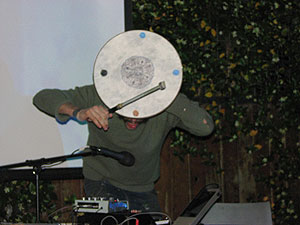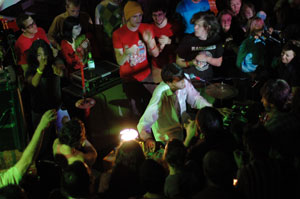A relatively new Spring tradition in Houston is the annual Media
Archeology Festival presented by the Aurora Picture Show. Now in its
fourth year, this festival of live electronic and performance art is
emerging from the underground, and is easily comparable to similar
mini-festivals and one-night events in cities such as New York,
Portland, Oregon, and Los Angeles.
This year’s Media Archeology, guest curated by New York’s charismatic Nick Hallett, included three full nights of performances in several of the city’s hippest venues. This year’s theme, Below Fi, featured “hackers, benders and overall fans of the analog” — artists concerned with utilizing non-digital techniques in their work.
The festival kicked off with an “expanded cinema” program showcasing performances by Ray Sweeten and Bruce McClure at the Aurora’s own converted church-micro-cinema in the Houston Heights. Sweeten’s set was performed with deft precision using an oscilloscope to provide generative Lissajous figures as visual accompaniment to his electronic music compositions. McClure’s 6’s Two 8’s: Dopes to Infinity was a challenging structuralist performance employing heavily modified 16mm film projectors that sent many in the audience scrambling for their earplugs. The Q&A session following the performance provoked questions about the artists’ hacked machines, fostering a dialogue ranging from the esoteric to the utterly geeky.
Night two took place in the courtyard sanctuary behind Domy Books, which shares backyard space with the hipster-haunt café Brasil. As the audience quietly sipped raspberry margaritas, Dynasty Handbag (aka Jibz Cameron) stunned us with her trashy getup and amazing body language. Drawing on feminist performance art tradition, Cameron sang, twitched and gesticulated in conversation with her recorded voice and a homespun Electro soundtrack.
{youtube}CS54krWdovM{/youtube}
The second set, by Nautical Almanac, represented the Circuit Bender movement. The artists brought an impressive array of “bent” instruments: off-the-shelf technology that’s been thoroughly hacked to produce new, unintended sounds. This performance was particularly anti-musical, involving percussive and explosive blips and bleeps. It appeared to be a largely unstructured improvisation intended to create a visceral connection between the sound and the performer’s bodies. We noted an affinity with the early music of John Cage, but the performance was flavored with the baggage of New Age politics … which we found to be distasteful in combination with the musical assault.
This evening also introduced us to the visuals of Mighty Robot, who supported both acts using an elaborate optical contraption to create moving images. Their setup can only be described as a mad scientist’s VJ lab, including a light table, water, transparencies, motors, camera, LED lights, slide projector and various other objects employed to create “interferences” in the projection. Most notably, there was not a laptop to be seen anywhere. This very tactile approach to live visuals was most gratifying in a Luddite sense.
We returned for the final night of the festival, which was held at The Orange Show, the spectacular folk-art monument in Houston’s East End. Just about any show is great at The Orange Show, because the place is so uniquely weird. Tonight was no exception. By this point a sense of camaraderie had emerged among the festival-goers, and we found ourselves greeting strangers like old friends.
The show began with Tristan Perich, who exudes the sex appeal of a rock star with a video game / art damage slant. Wearing sunglasses and a vest created entirely of zippers, Tristan plugged in his limited “1bit music” CD, which is actually a jewel case filled with various circuits that play 40 minutes of “live” music. The sound was akin to a fuzz-boxed Atari, and as the coarse, electro-synth melodies began to pulse, Perich proceeded to play his drum kit furiously, creating a live drum-and-bass track. He plays in a style that emulates what typically only computers can accomplish, which was interesting: there was always a sense of being “off,” which in the end was actually quite charming.
The grand finale of the festival was a “Swamp-Tech” set by Quintron and Miss Pussycat. PopMatters has called them “the baddest one-man band in America, sure to move your ass and make you laugh,” and they undoubtedly lived up to this claim. Quintron sat at a large organ + Moog trap, complete with Leslie cabinets and car headlights that he lit up on command. Casio-tone beats and a strange, light-triggered circuit-bent synthesizer accompanied Quintron’s Pentecostal-punk fervor on the organs. Miss Pussycat, dressed in baby blue with a pompom on her head, played maracas while wailing the vocals. A spirited Mighty Robot broke out his film projector, fully keeping pace.
“Everybody stand up!” Quintron yelled, and the audience collectively obeyed. Quintron later beckoned the audience to “join them in the pool,” and gleefully the crowd climbed “into the stage” for some serious bopping. The Orange Show shook with new life that would have made Jefferson Davis McKissack proud.
When first reading Hallett’s essay for this year’s festival, we misread the title “Return of the Native” as “Return of the Naïve.” Not in a negative sense, but rather in the sense of the hobbyist who toils away for hours in the basement. In a time exemplified by “user-generated content” such as YouTube, Facebook, MySpace and Flickr, a naïve-tech revolution is replacing the polished, specialized productions of the mass media (music, television and film). Hallett’s title suggests there is something inherently primitive about what we’ve seen here … or perhaps this is simply evolution. In any case, you should keep your eyes on the Aurora Picture Show: with this year’s Media Archeology Festival, they have cemented their place as headquarters of Houston’s growing new media scene.
See you next year!
Images courtesy Aurora Picture Show
Bree Edwards is an independent curator and program manager at the
Cynthia Woods Mitchell Center for the Arts at the University of Houston.
Johnny DeKam is a video artist/VJ, both are based in Houston.










